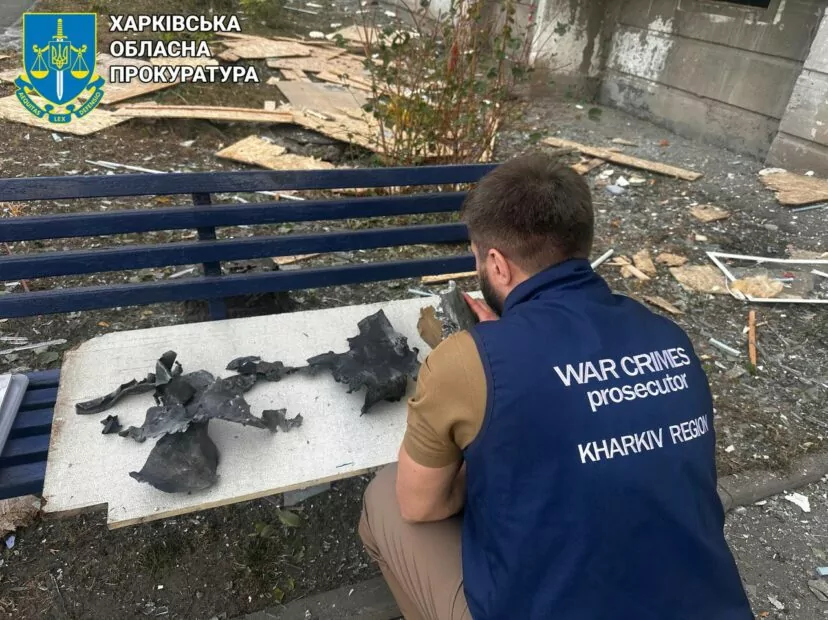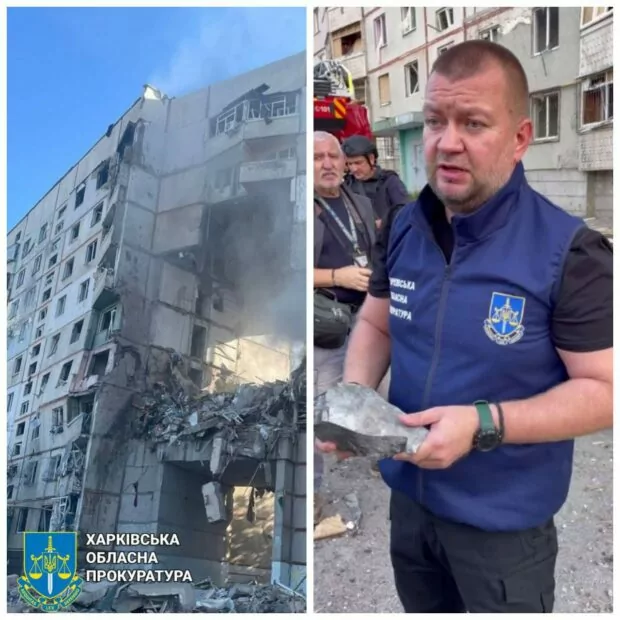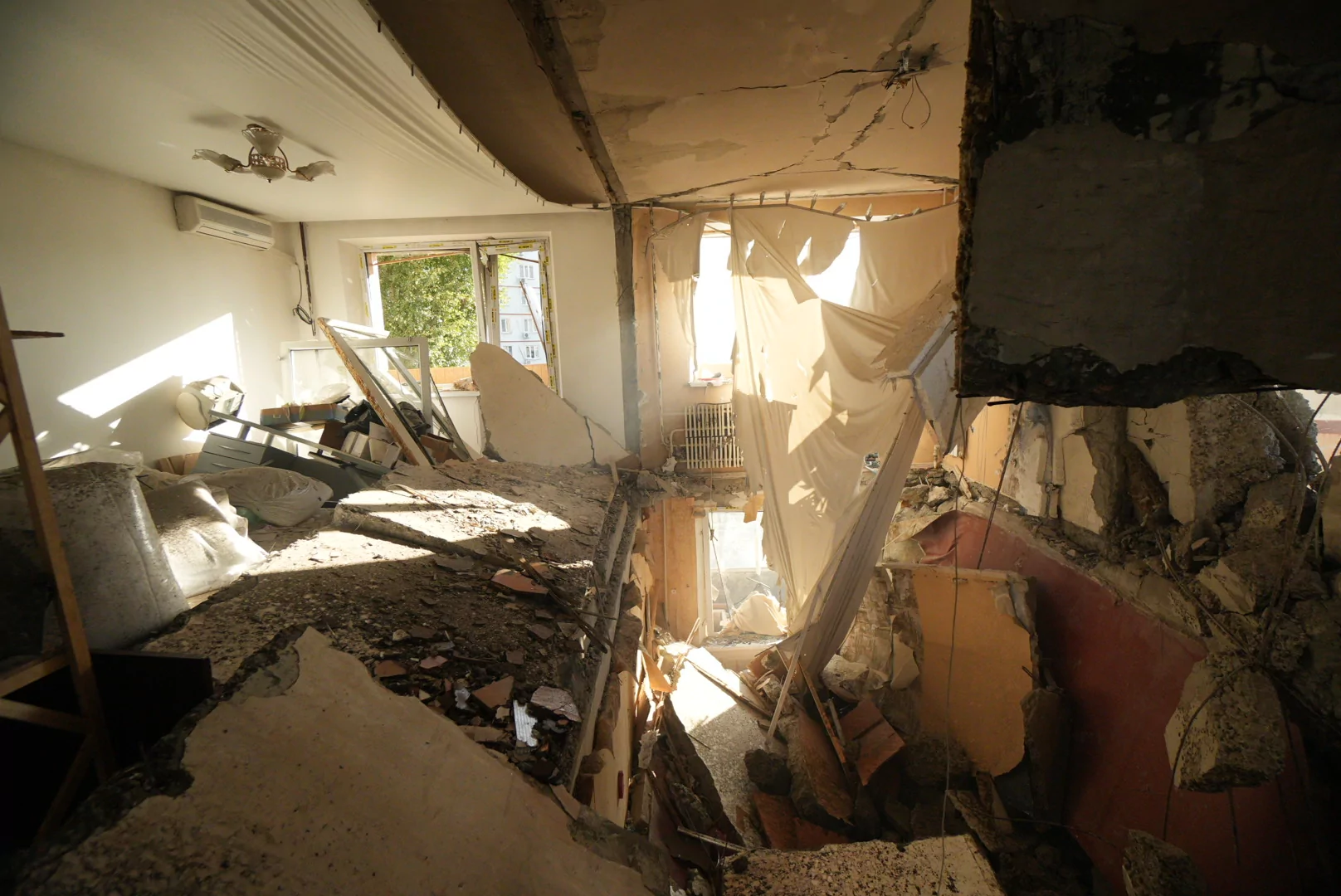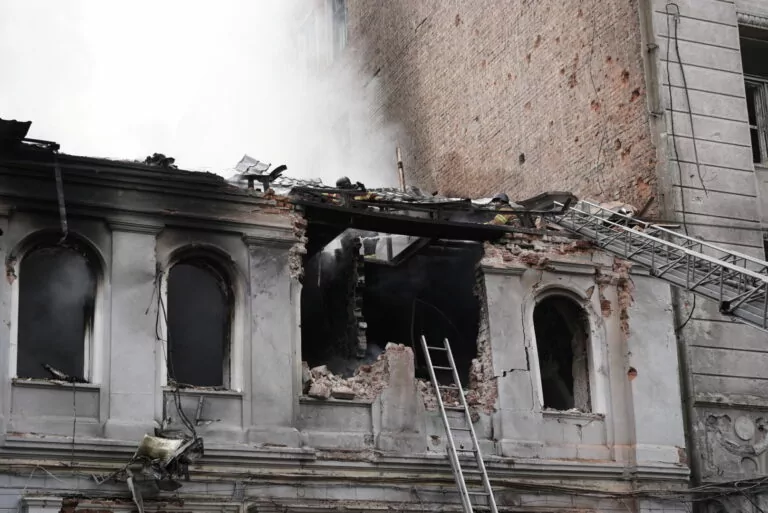On September 24, 2024, the Russian military once again hit Kharkiv with glide bombs. In the Kyivskyi district of the city, a glide bomb hit a high-rise apartment, completely demolishing five of the floors in one of the entrances. Meanwhile, Russian propaganda, trying to excuse an attack that targeted civilian infrastructure, which is a violation of international laws and customs of war, traditionally claimed that the building “was affected/suffered by the hands of the AFU (Armed Forces of Ukraine)”. Our fact-checking department looked into this claim.
What happened
Telegram channels “Russkii Z Kharkov V” (“Русский Z Харьков V“) and “Na samom diele v Kharkove” (“На самом деле в Харькове“) which systematically conveys messages of Russian propaganda, posted the shots of a high-rise building damaged by the air attack and wrote that it’s “suffered because of the AFU.”

“And here is the building that suffered from [the actions] of the AFU. Ukrainian propaganda has already reported that seemingly a “FAB” hit [there]. But they still cannot pick the size of the aerial bomb, 250 or 500. In any case, even if that was the FAB-250, then it would have ruined all vertical [slabs] and affected horizontal [slabs] because the aerial bomb enters the target practically vertically. And if FAB fell near [the building], where is the crater from the impact? No one showed it,” the Telegram post says.
Analysis
First of all, we checked the official resources of the Kharkiv Oblast Police and Kharkiv Regional Prosecutor’s Office.
According to the police’s data, on September 24, Russians hit Kharkiv with airstrikes. They documented the strikes hitting Kyivskyi, Shevchenkivskyi, Nemyshlianskyi, and Saltivskyi districts of the city, and also registered attacks in the Kharkiv district of the Kharkiv Oblast, outside of the city.
“From 3:20 p.m. to 3:45 p.m., the Russians launched eight air bombs from their aircraft, targeting the Kharkiv region. One of the FAB-500 rockets hit a nine-story building in the Kyivskyi district of the city,” the law enforcement reported.
The police’s post was published before the one shared by the Telegram channels we’re analyzing, which debunks their claim that “law enforcement can’t pick what exact air bomb was used.”

The information that the strike at the high-rise was made with FAB-500 with UMPK module was shared by the Kharkiv regional prosecutor’s office, publishing a photo with the fragments of the bomb.

One of the fragments of the aerial bomb was demonstrated to journalists by Oleksandr Filchakov, the head of the Kharkiv regional Prosecutor’s Office, on the impact site.

Filchakov also said that Russians used three Su-34 jets to launch three glide bombs FAB 250-500 with UMPK modules from the settlement called Stroitel in Belgorod Oblast. Six of them hit Kharkiv.
What FAB and UMPK module are
FAB is a gilde air bomb with a high explosive warhead. UMPK is an attached module that is made to be used along with unguided air bombs, for instance, FAB-250 and FAB-500. Module transforms the bomb that is supposed to be dropped down from the jet in a guided munition, increasing its range up to dozens of kilometers.
Oleh Syniehubov, Kharkiv Oblast Governor, said that the Russian military started to actively use modified FAB-250 and FAB-500 to hit Kharkiv in July.
“In the past, they used this type of munition only in the Kupiansk and Kharkiv directions [to attack Ukraine’s troops positions — ed.]. Now, they modified it. Its reach is 80 kilometers, which is why it can reach any location in Kharkiv. All air raid alerts that continue for 10-16 hours are real and indicate the real threat,” Syniehubov said.
Is it possible to protect Kharkiv from KABs and FABs
It’s impossible to protect Kharkiv from air bombs now. The deputy head of the Kharkiv air defense brigade, Oleksandr (surname is omitted because of safety considerations), talked about it in an interview with the Suspilne Kharkiv.
To shoot down KABs from the anti-aircraft complex, Oleksandr said, you have to be in the zone of where the jets that launch them fly, in the zones of KABs. But because the Russian army used anti-radiolocation missiles (the reach of which is 100, 120, 150 kilometers, and much farther than that of KABs), the efficiency of the division [that operates anti-aircraft system] is very low in terms of shooting down KABs because the division will be destroyed very fast.
“We can’t reach the KABs to the launchers. If we’re talking about NASAMS [Norwegian Advanced Surface-to-Air Missile System — ed.], they have a short range, about 25 kilometers, depending on the type of target. So, their specifications won’t let them reach the jets that launch the bomb. Long-range complexes, Patriot, Samp/T, or Iris-T, can reach the jets. But again, with the way the density of the enemy’s aviation is, we aren’t allowed to utilize these complexes [without support].”
So, if Ukraine’s air defense could protect Kharkiv from KAB air strikes, then they would hit the launchers—jets that launch the bombs. The statement of Russian propaganda that the building “suffered at the hands of AFU” is Russian disinformation that is used to excuse the attacks on the city’s civilian infrastructure that killed and injured people.
Cover credit: Inside of the 9-story residential building after direct hit of Russian glide bomb on September 24 / Ivan Samoilov, Gwara Media
Conclusion: Fake
Read more
- Debunking Russian fakes. No, instructors from Sweden weren’t killed in Russian missile attack on Poltava
- “I covered my daughter with my body, so she is okay.” Day after Russian bomb hit high-rise in Kharkiv (photos)



